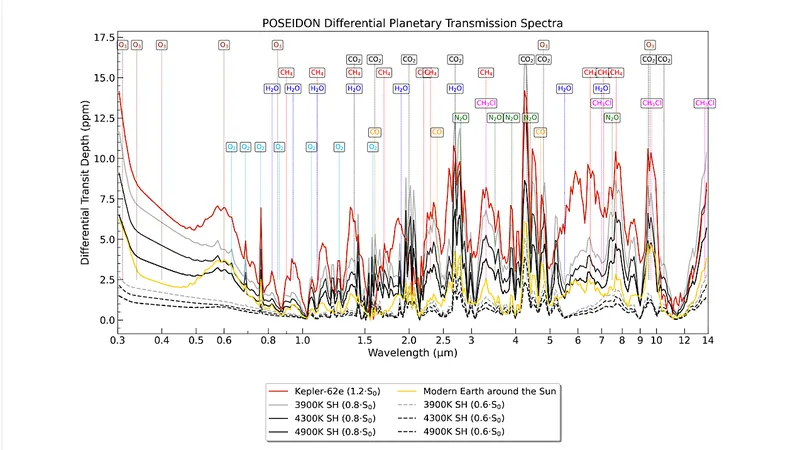
Transforming the Search for Life: K Dwarf Stars and Their Superhabitable Exoplanets
2025-01-08
Author: Mei
Introduction
In the ever-expanding quest to uncover life beyond our Solar System, researchers are shifting their focus towards a promising new frontier: superhabitable planets orbiting K dwarf stars. These planets may present conditions more conducive to life than even Earth itself. However, the potential of these worlds has remained largely uncharted due to insufficient modeling in their observability within the habitable zones of K dwarf stars.
Groundbreaking Study
A groundbreaking study has now turned the spotlight onto this understudied area, modeling the atmospheres of these superhabitable exoplanets. Utilizing advanced methodologies, including the sophisticated 1D model \(\mathcal{H}\mathcal{P}\mathcal{S}\) to determine superhabitable characteristics, scientists calculated synthetic transmission spectra and simulated observations with the James Webb Space Telescope (JWST) using comprehensive atmospheric data.
Findings
The findings are intriguing: planets orbiting mid-type K dwarfs—receiving around 80% of Earth’s solar flux—emerge as the most promising candidates for hosting life. Unlike those bathed in only 60% of solar flux, which could experience prohibitive levels of carbon dioxide, these K dwarf planets maintain temperate surfaces that could facilitate biosphere development more effectively.
Detection Advantages
In addition to nurturing life, these superhabitable planets boast distinct advantages when it comes to detection. They require fewer transit observations for spotting biosignature pairs, such as oxygen and methane. Specifically, detecting these gas combinations from a distance of 30 parsecs would necessitate only about 150 transits (equivalent to roughly 43 years) for a superhabitable world, in stark contrast to the daunting requirement of over 1,700 transits (around 1,700 years) for Earth-like planets orbiting Sun-like stars.
Future Implications
Although these observation timelines extend beyond the JWST's operational duration, the study highlights an urgent need for next-generation telescopes. The European Extremely Large Telescope (ELT) and other future observatories could play pivotal roles in expanding our understanding of these intriguing worlds.
Conclusion
The implications of this research are vast and suggest that the cosmos may hold far more secrets than we have anticipated. With K dwarf stars and their potential superhabitable planets at the forefront, the search for extraterrestrial life could enter an exciting new chapter. Stay tuned as we uncover more about these remarkable candidates that could redefine our understanding of life beyond Earth!
 Brasil (PT)
Brasil (PT)
 Canada (EN)
Canada (EN)
 Chile (ES)
Chile (ES)
 Česko (CS)
Česko (CS)
 대한민국 (KO)
대한민국 (KO)
 España (ES)
España (ES)
 France (FR)
France (FR)
 Hong Kong (EN)
Hong Kong (EN)
 Italia (IT)
Italia (IT)
 日本 (JA)
日本 (JA)
 Magyarország (HU)
Magyarország (HU)
 Norge (NO)
Norge (NO)
 Polska (PL)
Polska (PL)
 Schweiz (DE)
Schweiz (DE)
 Singapore (EN)
Singapore (EN)
 Sverige (SV)
Sverige (SV)
 Suomi (FI)
Suomi (FI)
 Türkiye (TR)
Türkiye (TR)
 الإمارات العربية المتحدة (AR)
الإمارات العربية المتحدة (AR)